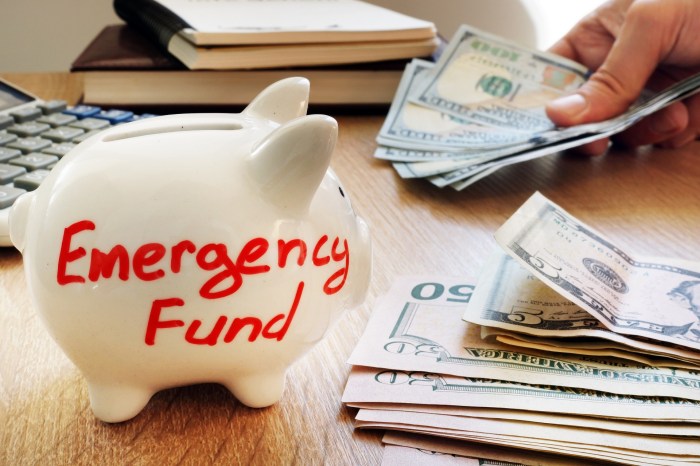Picture this: you’re cruising along, minding your own business, when suddenly life throws you a curveball. With no safety net in place, you’re left scrambling to cover unexpected expenses. But fear not, because in this guide, we’re diving into the world of emergency funds – your secret weapon for financial stability. Get ready to learn how to build, manage, and make the most of your emergency fund like a boss.
Importance of Emergency Funds

Having an emergency fund is crucial for financial stability. It acts as a safety net during unexpected financial challenges, providing peace of mind and preventing individuals from going into debt.
Examples of Unexpected Expenses
- Medical emergencies that require immediate attention and costly treatments.
- Car repairs or accidents that are not covered by insurance.
- Job loss leading to a temporary loss of income.
Recommended Size of an Emergency Fund
Experts suggest having at least three to six months’ worth of living expenses saved in an emergency fund. This amount can vary based on individual circumstances, such as job stability, health conditions, and overall financial situation.
Building an Emergency Fund
Building an emergency fund is crucial for financial stability and peace of mind. It serves as a safety net during unexpected events like medical emergencies, job loss, or car repairs. Here are some strategies to help you build an emergency fund:
Setting a Savings Goal
- Calculate your monthly expenses: Determine how much you need to cover 3-6 months of living expenses.
- Start small: Set achievable savings goals to gradually build your emergency fund.
- Automate savings: Set up automatic transfers from your paycheck to your emergency fund account.
Allocating Income Towards the Fund
- Establish a budget: Track your expenses and identify areas where you can cut back to allocate more towards savings.
- Pay yourself first: Prioritize saving for emergencies by setting aside a portion of your income before spending on non-essentials.
- Consistency is key: Make saving a habit by setting aside a fixed amount each month.
Short-Term vs. Long-Term Emergency Funds
Short-term emergency funds are typically used for immediate expenses like car repairs or medical bills, while long-term emergency funds are for larger unexpected events like job loss or major home repairs.
- Short-term fund: Aim to have 1-2 months’ worth of expenses in this fund for quick access.
- Long-term fund: Build this fund to cover 3-6 months or more of living expenses for prolonged financial emergencies.
- Invest wisely: Consider putting long-term emergency funds in a high-yield savings account or other low-risk investments for better returns.
Where to Keep Emergency Funds
When it comes to deciding where to keep your emergency funds, you have a few options to consider. Each option has its pros and cons, so it’s important to choose the one that best fits your financial goals and needs.
Savings Account
- A savings account is a common choice for storing emergency funds because it offers easy access to your money.
- Pros: Easy to access, typically earns some interest, and funds are FDIC insured up to certain limits.
- Cons: Interest rates may be low compared to other options, and it’s easy to dip into the funds for non-emergencies.
Money Market Account
- A money market account is similar to a savings account but may offer higher interest rates.
- Pros: Higher interest rates compared to regular savings accounts, easy access to funds, and FDIC insured up to certain limits.
- Cons: Some accounts may require a higher minimum balance, and interest rates can still be relatively low.
Cash
- Keeping a portion of your emergency fund in cash can be a good idea for immediate needs.
- Pros: Immediate access to funds in case of emergencies, no risk of market fluctuations affecting the value of your funds.
- Cons: Risk of loss or theft, no opportunity for your money to grow through interest.
Remember, the key factors to consider when choosing where to keep your emergency funds are accessibility and liquidity. You want to be able to access your funds quickly in case of an emergency, but also ensure that they are earning a decent return while being kept safe.
Using Emergency Funds Wisely
In times of financial need, it is crucial to use your emergency fund wisely to ensure you can bounce back from unexpected expenses. Here are some best practices to consider when utilizing your emergency fund:
Determining When to Use Emergency Funds
- Only use your emergency fund for true emergencies, such as medical expenses, car repairs, or unexpected job loss.
- Avoid using your emergency fund for non-essential purchases or expenses that can be budgeted for in advance.
- Consider the urgency and impact of the situation before tapping into your emergency fund.
Replenishing Your Emergency Fund
- After using your emergency fund, make it a priority to replenish the amount as soon as possible.
- Set a budget and allocate a portion of your income towards rebuilding your emergency fund.
- Consider cutting back on non-essential expenses to speed up the replenishment process.
Examples of Wise Use of Emergency Funds
- Unexpected medical expenses that are not covered by insurance.
- An essential home repair, such as a leaky roof or a broken furnace.
- Losing your job and needing financial support while searching for a new one.
